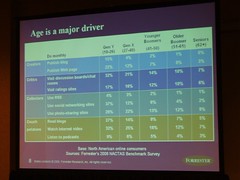(Continuing notes from today’s Forrester Consumer Forum. More here.)
Solid overview from Harley Manning on how “inhuman” technology-based connections can be, as well as some things that can be done to improve them. The highlights:
What’s Inhuman?
Inhuman examples:
- Questions that are nonsensical in the real world: “What country are you in?” is a commonly-asked inquiry at many websites. Think about this in the real world…how many times have you been asked that when going into the store? “Hi, welcome to Bed, Bath and Beyond…what country are we in?”
- Jargon, jargon, jargon: The Motorola only spec sheet for one of their phones states : “PIM funcationality”…when was the last time anyone ever used that phrase? (Goes back to the example from yesterday at the online shopping site for Bloomingdales, have you ever used the phrase “Casual China” in real conversation? “Honey, the Wilsons are coming over for dinner, can you please put out the Casual China?”)
Expectation setting in design is also key. Harley gave a great example of trying to make a deposit at a BofA automated teller machine. The website said he could make a deposit. The physical signage above the machine said “All Transactions”…yet, “deposit” was not an option on any of the ATM menus, despite the fact that the physical machine had a deposit slot!
How to humanize the interactions?
The suggestion is to adopt “human-centric” design practices:
- Not “tech-centric”
- Not “self-centric”
- Not even “user-centric”…people are PEOPLE first, THEN users
Human centric design has three practices:
A) Enthographic research
Derived from cultural antrhopology. Interview and observe. Distill observations into “segmentation models.” Rep each “persona” as a vivid description.
[ed. – I had a little bit of issue with this point in particular…the granularity that is lost when coming up with what is, in effect, a stereotype seems a little bit contrived. We all have so many facets of our selves that putting any individual into a stereotypical segment seems a bit off to me.]
B) Scenarios
Donald Cho scenario
At each step note what things YOU (the system provider) are responsible for, define what is done at each step, and show how channels work together
C) Expert reviews
- Start with expert-derived list of common user experience problems
- Identify goals for each channel
- Reviewers try to accomplish each goal, while looking for each problems on the list
- Great for: giving a common checklist, find basic navigation flaws, shines a spotlight on presentation problems
Ex: Macromedia.com
- Personas highlighted problems (marketing speak in the developers section)
- Half of site received little or no usage
- Redesigned site after reviews
- Home page abandonment down 11%
- Conversion up 297%
- Units sold per visit went up 67%
Ex: Cellular One
- Installed phone self-service: complaints up, transfers b/w reps up
- Observed 300 callers
- Customer satisfaction up after the redesign
- Automation rates up, 76% of customer payments now handled
- 100% ROI in < 3 mos.
Is it worth it for you?
Harley’s point on building an ROI model. Not rocket science; basic blocking and tackling.
1) List explicit business goals for the channel
E.g For a website: conversion rates, avg order size are common metrics
2) Document current channel performance
For the goals above, list current values of the agreed upon metrics (e.g. current conversion rate is 2.6%)
3) Agree on possible ranges of improvement
E.g. website conversion rate increase of 10%-25%, ATM transaction rate improvement of 1% to 2%
4) Estimate costs
Go internally, or get external expert model (e.g. $500K to improve website)
5) Run what if scenarios
This is where the “magic” happens, however. [ed. — One can say that an activity “will increase conversion rates by 2.6%…but the best-laid-plans, etc….Manning glossed over this point. It’s ultimately all about execution.)
Ex: Eddie Bauer redesign
Spent $124,150 on design and dev, estimated added $5.5MM in profit as a result of the redesign.




 A net-positive presentation from Roger C. Hochschild, President and COO, Discover Financial Services. Hochschild seems to get it. Two particular areas of focus of note, with respect to connecting with their customers: Clarity and Control.
A net-positive presentation from Roger C. Hochschild, President and COO, Discover Financial Services. Hochschild seems to get it. Two particular areas of focus of note, with respect to connecting with their customers: Clarity and Control.

